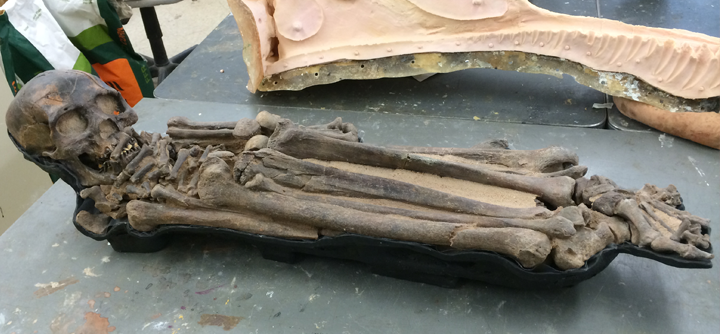
Kiffian. (Photography by Maureen Searcy)
A photographic tour through Paul Sereno’s Fossil Lab.
Long before Barney and Friends turned dinosaurs into plush, huggable, musically inclined pals, I learned about them through picture books and museum bones. I developed a healthy measure of fear of the “terrible lizards” that—because I was fairly sure I wouldn’t encounter one—morphed into an obsession.
Sadly my love for these prehistoric behemoths had dimmed in comparison to more contemporary obsessions; I had little reason to think about dinosaurs save for lamenting my T. rex arms when unable to reach something. But when professor and famed paleontologist Paul Sereno decided to team up with his daughter’s fourth-grade Laboratory Schools class to build a dinosaur model, that old infatuation fired right back up.
Sereno, fourth-grade teacher Lisa Sukenic, and art department chair Gina Alicea collaborated to build a “flesh model” of a Rajasaurus, a theropod that lived 65 million years ago, discovered by Sereno. His Fossil Lab created resin skull replicas, and the students applied clay to add muscles, skin, and scales and used taxidermy glass eyes to create a sculpture of how they imagined a live Rajasaurus looked.
[[{"type":"media","view_mode":"media_original","fid":"1331","attributes":{"alt":"","class":"media-image","height":"354","typeof":"foaf:Image","width":"460"}}]]Rajasaurus resin skull replica.
[[{"type":"media","view_mode":"media_original","fid":"1332","attributes":{"alt":"","class":"media-image","height":"354","typeof":"foaf:Image","width":"460"}}]]A Raptorex flesh model was brought to class as an example for the students.
To research the collaboration, I took a tour of Sereno’s Fossil Lab with resident paleoartist and fossil preparator Erin Fitzgerald. I spent most of the tour squealing in delight. I asked if Sereno ever sold resin bone replicas, ostensibly out of curiosity but really because I was eaten up by jealousy and wanted to make a flesh model for myself. The answer: yes, but I probably can’t afford it.
Fitzgerald showed me flesh models that she and colleague Tyler Keillor made:
[[{"type":"media","view_mode":"media_original","fid":"1333","attributes":{"alt":"","class":"media-image","height":"368","typeof":"foaf:Image","width":"460"}}]] Erin’s version of Rajasaurus narmadensis.
Please note the strings of saliva made of glue.
[[{"type":"media","view_mode":"media_original","fid":"1334","attributes":{"alt":"","class":"media-image","height":"394","typeof":"foaf:Image","width":"460"}}]]Rugops primus.
[[{"type":"media","view_mode":"media_original","fid":"1335","attributes":{"alt":"","class":"media-image","height":"359","typeof":"foaf:Image","width":"460"}}]]Heterodontosaurus (spikey) and Nigersaurus (smiling).
Then there were the actual fossils.
[[{"type":"media","view_mode":"media_original","fid":"1336","attributes":{"alt":"","class":"media-image","height":"359","typeof":"foaf:Image","width":"460"}}]]Where the magic happens.
In this room the preparators saw, chip, and scrape through stone to reveal fossils. Those giant hoses are vacuums to suck up all the dust so the staff doesn’t breathe it in.
[[{"type":"media","view_mode":"media_original","fid":"1337","attributes":{"alt":"","class":"media-image","height":"359","typeof":"foaf:Image","width":"460"}}]]An actual Tyrannosaurus rex arm.
It really is quite small for a dinosaur, poor thing.
[[{"type":"media","view_mode":"media_original","fid":"1338","attributes":{"alt":"","class":"media-image","height":"576","typeof":"foaf:Image","width":"460"}}]]
[[{"type":"media","view_mode":"media_original","fid":"1339","attributes":{"alt":"","class":"media-image","height":"282","typeof":"foaf:Image","width":"460"}}]]Sarcosuchus imperator, aka Super Croc.
I wish I could have stretched out next to it so you could see how big this thing is—and that’s just its head. Super Croc could grow up to 40 feet long and weigh up to eight metric tons. The jaws alone are six-feet long. Absolutely terrifying.
Sereno’s collection also includes ancient human specimens, like these remains from Gobero, a dig site in Niger. These people lived in what’s called “Green Sahara,” 10,000 to 5,000 years ago when the area had lakes and a humid climate.
[[{"type":"media","view_mode":"media_original","fid":"1340","attributes":{"alt":"","class":"media-image","height":"432","typeof":"foaf:Image","width":"460"}}]]
Kiffian male.
The Kiffians, a tall and sturdy-boned people, first settled around Gobero 9,700 years ago.
[[{"type":"media","view_mode":"media_original","fid":"1342","attributes":{"alt":"","class":"media-image","height":"343","typeof":"foaf:Image","width":"460"}}]]
[[{"type":"media","view_mode":"media_original","fid":"1341","attributes":{"alt":"","class":"media-image","height":"602","typeof":"foaf:Image","width":"460"}}]]Tenerean female and two juveniles.
The shorter and slighter-built Tenereans settled the area 7,000 years ago.
See the dinosaur models at LabArts in Shapiro Hall, April 25–27.
